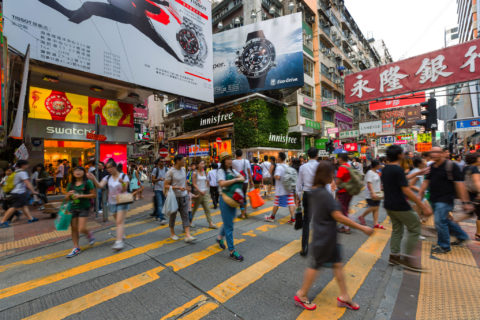By Jacob Harbord
I recently wrote about the strengths and weaknesses of what I’ve dubbed ‘VirtuQual’. This is the use of 360 filmmaking within qualitative research. I’m aware that translating the theory behind this into practical application is critical. Resultantly, here we’ll discuss a range of potential VR uses – all of which are linked to commercial research challenges.
Context
Client’s responsibilities are being globalised, with less budget and time allowances. This means clients often can’t meet their customers face-to-face due to logistical, time and cost issues. VR offers a solution for this. It can help us simulate consumer immersions within the convenient confines of the boardroom, and extend this experience to a global organization. This can certainly replicate a traditional immersion, showing 1x consumer in 1x market, but I would argue that the real value of VR lies in the new types of immersion it facilitates.
VR allows us to go beyond a single consumer or market and, within a short space of time, allows clients to immerse themselves in:
- Market level immersions
- Global immersions
- Longitudinal immersions
- Post framing auto-ethnography
- Social aesthetics
I’ll discuss each of these in turn and illustrate my thinking with a short film I’ve produced called ‘Welcome to Singapore’ which you can view below.
Market Level Immersion
Description: ‘Welcome to Singapore’ is a clear example of how we can immerse viewers in a variety of environments which typify a whole market. In a couple of minutes, we can see urban infrastructure, green spaces, religious and cultural performances, typical dining behaviours, and the shift in character from day to night.
Value: For use within regional or global presentations and workshops, where clients may have little tangible understanding of a market. From the comfort of corporate headquarters, they can rapidly develop a gut-feel for a country’s culture and environment. This avoids static reports undermining an appreciation of socio-cultural difference and our subsequent ability to land key insights.
Global Immersion
Description: Global immersions explore multiple markets according to specific themes. For instance, we could take the scene of a family eating dinner in ‘Welcome to Singapore’ and contrast this with other families from across the world.
Value: This helps global or regional clients rapidly compare the reality of life across markets. It also brings social and environmental differences into sharp relief and generating insight that may otherwise require extensive travel.
Longitudinal Immersion
Description: The time-lapse at the end of ‘Welcome to Singapore’ highlights our ability to compress time. We could use this to create immersions which span several days, such as observing how consumers use their kitchens or living rooms over an entire weekend.
Value: Time-lapsed immersion can integrate several observational and even quantitative methods within a compelling piece of narrative filmmaking. For example, dry-and-dusty appliance usage frequency counts could be presented through a time-lapse VR film, helping liven-up presentations and place such data within a real-world context.
Post-Framing Auto-Ethnography
Description: This was inspired by Chelsea Gibbon’s (iModerate) and Emily Hsiao’s (Bare Snacks) excellent presentation at the ESOMAR Global Congress. They showed that we can take 360 footage, open it within a desktop player, and record the screen as we click-and-drag the POV within that player. This allows us to create a 2D video in which we control the POV during post-production. They used this technique to produce high-quality and insightful content from in-home placements and shop-alongs, where consumers were given 360 cameras to document their experiences.
Value: This can add excellent value to in-home product placements and any study where we place cameras with consumers. Anyone who’s previously tried this will know that untrained consumers often produce poor quality material to the detriment of our final deliverables. This allows us to compensate for jerky/poorly framed material recorded in-home or even when shopping, sidestepping the risk of nausea when viewing via VR headset.
Social Aesthetics
I believe this is the most exciting area for VR, but also the most challenging. At a basic level, it’s quite straightforward – round tables with food in the middle encourage sharing; chairs facing opposite directions discourage talking. But what about the subtle influence our environments have on our psychology, and all the little nudges they give to our System 1 thinking?
Think about how difficult it is to demonstrate how an environment shapes someone’s behaviour. Yes, we can do this in a controlled space like a supermarket, but what about the living room of a Thai housewife or the streets of New York? We can’t simply ask people since it’ll largely be System 1 type thinking which is influenced; we can’t do the usual behaviour science tests, because we cannot shape the space nor provide easy comparisons.
The answer certainly lies in the integration of multiple different perspectives such as ethnography, behavioural psychology, environmental and spatial studies. Even neuroscience, which in some distant future might allow us to track complex internal thought processes. In any case I’m unable to provide a satisfactory answer at present, but watch this space!
Final Thoughts
Maybe you see the value in such use cases, maybe you don’t. What’s undeniable is the exciting opportunity this technology presents. We’re at the cusp of a visual revolution and, beyond just market research, we have the power to shape and define the development of a new visual system. We must invent its uses and develop creative applications for resolving pressing business issues.
I hope you’ve found this article interesting and informative. I’m always keen to discuss this subject further, so do get in touch if you’d like to continue the discussion!
By Jacob Harbord, IPSOS


